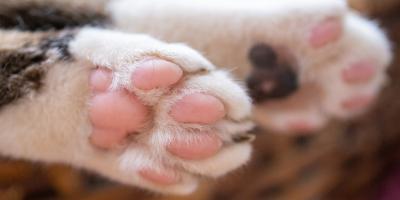Cat Ear Infections and Common Ear Problems


Cat ears – just like ours – are sensitive things, and should always be handled with care. Your cat’s ears should always be clean, with no thick brown or green waxy discharge, and there shouldn’t be any redness, itchiness or unusual smells.
If your cat starts to scratch their ears, shake their head more than normal, hold their head to one side or rub one side of their face, they might be trying to let you know something’s not quite right. One of the main reasons why you should take them to the vet to have their ears checked is because severe cat ear problems can have more serious effects and lead to ear infections. Here are the signs and possible solutions for a cat dealing with ear problems such as infections.
What Are the Signs of Cat Ear Infection?
Some of the most common symptoms of ear infection in cats include:
- Discharge from the ear
- Ear scratching
- Redness of the ear flap
- Strong odor
- Constantly tilting their head
- Scabs and hair loss around the ears
- Loss of balance
If you notice these symptoms, it’s always best to visit the vet. There are lots of reasons why cat ear problems can occur, but thankfully, your vet will be able to examine your cat’s ears safely and tell you what tests or treatment might be needed to get them back to tip-top condition.
What Are the Causes of Ear Infection in Cats?
Infections affecting the ear can seem like they’ve appeared out of nowhere, but it is important to determine what has caused the infection. The origin of your cat’s ear problem will help determine the most efficient way to get it treated and have your cat back to their normal self as quickly as possible. These are some of the ways your cat’s ears can get infected:
1. Ear Mites
These tiny creatures are usually under a millimeter long, but can find their way to your cat’s ear and cause irritation and inflammation. The vet will be able to diagnose the ear mite infestation by analyzing the debris from your cat’s ears and recommend an anti-parasitic wash to help get rid of the mites.
2. Skin Allergies
If your cat is experiencing a skin allergy due to certain parasites, they can develop symptoms such as itchiness around the ears, causing them to scratch the area and produce lacerations that can easily get infected.
3. Ear Injuries
Injuries that are not properly cleaned can also lead to infections. Since cats are known for their explorer spirit, you should keep an eye on scratches, wounds or any sign of trauma, especially if your pet is spending a considerable amount of time outdoors. A cat’s ear infection can start from even an unsuspecting abrasion if bacteria gets hold of the area. This is why it’s important to keep scratches clean, and don’t hesitate to ask for your vet’s help for any deep wounds you notice.
4. Foreign Bodies
Cats can also end up with all sorts of objects lodged into their ear. Grass is a particular cause of concern, so if you notice your cat pawing at their ears, take a look to see if a foreign body has managed to end up in your pet’s ear canal. Most of these “intruders” can be safely removed by the vet to avoid the possibility of a cat ear infection.
5. Wax Build-up
It is important to keep your cat’s ears clean. Too much dirt accumulated from their daily adventures or excessive wax build up make up the perfect environment for bacteria to start developing. So clean your cat’s ears regularly to prevent possible infections.
Types of Cat Ear Infection
Your cat’s ear problems can affect the outer ear or the internal and middle parts of the ear.
Outer Ear Infections in Cats
The outer part of your cat’s ear, also called the pinnae, can easily be affected by wounds. Whether it’s a bit of rough play or getting into a fight with a fellow cat, the ears can get scratched or even bitten in the process. This doesn’t necessarily lead to an infection, but it’s important to look out for signs of redness or swelling and ask the vet for advice.
Internal and Middle Ear Infections in Cats
The ear canal can end up hosting anything from mites to bacteria and foreign bodies which makes it slightly likelier that an ear infection will be located in these areas. Sometimes even an outer ear infection can travel deeper into the ear causing your cat to start shaking or tilting their head or rubbing their ears. Polyps might also develop in the middle ear and can also cause an ear infection.
How Are Cat Ear Infections Treated?
One of the first things the vet will do once your cat has been diagnosed with an ear infection is establish the cause. If the cat ear problem originated from dirt or excessive wax, the vet will clean the ears and recommend ear drops to combat the bacteria and alleviate the swelling.
Your vet will be able to recommend a gentle cleaner that will be kind to your cat’s ears, and they’ll also show you how to use it properly. There are lots of different types of ear treatments available, from external drops to medicines that need to be administered straight into the ear canal. If you’re not sure how they should be administered, chat to your vet to get them to clarify it for you. Make sure you use a vet-approved treatment – don’t use an over-the-counter remedy without your vet confirming that it’s okay first. Antibiotics might be recommended for more severe infections.
Helping to Prevent Cat Ear Problems
You can help keep cat ear infections to a minimum by keeping their ears clean and checking them regularly for anything unusual. After all, the sooner you see that something is amiss, the sooner you can get it sorted. Some cats might benefit from regular ear cleaning with special ear cleaners, as recommended by your vet, but remember that cat ears are very delicate and the eardrum can be very easily damaged, so never poke anything into your cat’s ears.
Cats with white-tipped ears are more at risk of sun damage to their skin on their ears, which can potentially lead to cancer, so consider massaging a small smear of sunscreen lotion onto them to protect them during hot and sunny days.
One of the best ways to prevent infections and other health problems is by conducting regular and thorough health checks for your cat in order to spot any unusual signs early on. For more tips from Purina experts on cat conditions, explore our other cat skin, fur and ear articles.
Related articles

Earn myPurina Rewards with Every Purchase
Use your points for treats, toys, and gift cards with myPurina app.






